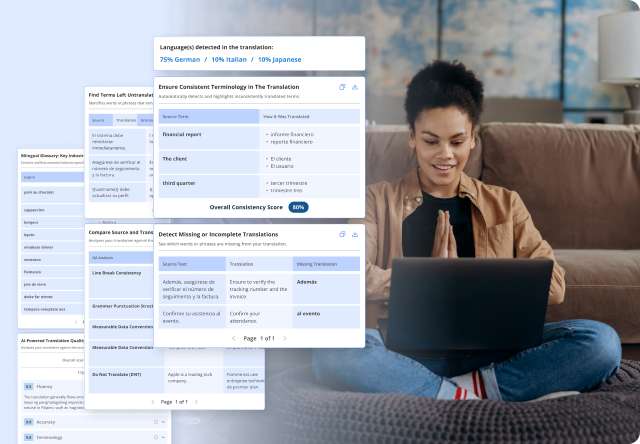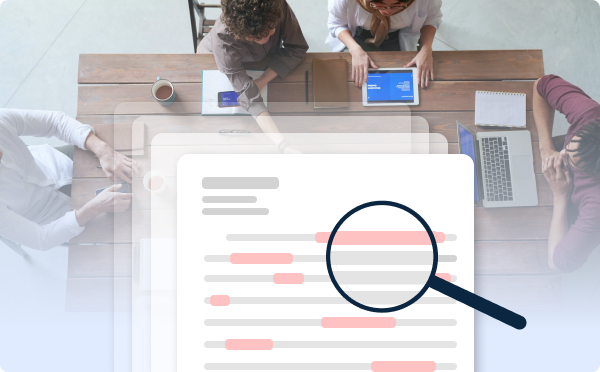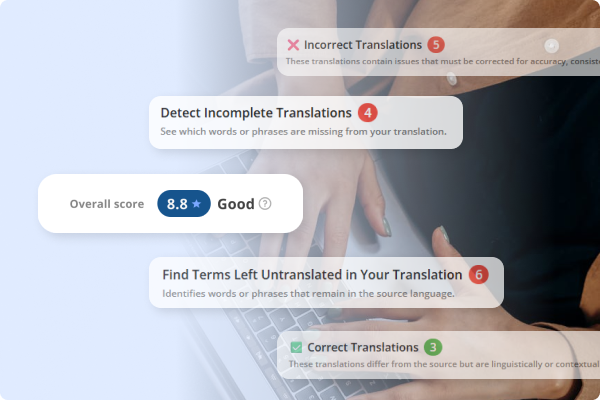Translation Quality Assessment Tool
Check translation quality for free
Run a side-by-side comparison of your source and target text in seconds.
The Tomedes Translation QA Tool highlights missing content, inconsistent terminology, and linguistic errors, then assigns an objective quality score so you can deliver polished translations without costly revisions.
It provides a comprehensive framework for measuring translation and linguistic quality, helping linguists, businesses, and localization professionals produce translations that meet the highest QA standards.
Comprehensive translation QA features
Get a full-spectrum translation quality audit in one click. The tool automatically.
Counts words in both texts - instantly shows source and target word totals.
Detects languages present in the translation lists each language with its percentage share.
Calculates the word-count ratio - flags if the translation is noticeably longer or shorter.
Generates an AI quality score - overall and per category (fluency, accuracy, terminology, style, grammar) so you know exactly where to improve.
Flags untranslated terms - highlights words or phrases left in the source language.
Finds incomplete translations - pinpoints missing segments that still need to be rendered.
Finds incomplete translations - pinpoints missing segments that still need to be rendered.
Marks incorrect translations - identifies content requiring correction for accuracy, consistency, or localization.
Confirms correct translations - indicates differences that are linguistically or contextually justified.
Builds a bilingual glossary - extracts key industry terms and pairs each with its translation.
Runs a consistency checker - automatically reveals terms translated in multiple ways across the document.
What Translation Quality Assessment (TQA) means
Translation Quality Assessment (TQA) is a structured process for judging how well a target text conveys the meaning, style, and intent of the source. A robust TQA framework answers five core questions:
Accuracy - Did the translator preserve meaning and nuance?
Fluency - Does the target read naturally to a native speaker?
Terminology - Are industry terms used consistently and correctly?
Style - Is tone, register, and branding aligned with client guidelines?
Completeness - Is any content missing, added, or left untranslated?
Within professional localization workflows, TQA is often embedded in Linguistic Quality Assurance (LQA) programs—ongoing, data-driven checks that keep global content on brand and in compliance with standards such as ISO 17100, MQM, and TAUS DQF.

Linguistic Quality Assurance typically involves:
Error Typology & Weighting
Classifying issues as critical, major, or minor (e.g., mistranslations vs. punctuation slips).
Sampling Plans
Reviewing a statistically valid slice of large projects to project overall quality.
Quality Thresholds
Defining pass/fail scores or Service Level Agreements (SLAs) with vendors.
Style
Is tone, register, and branding aligned with client guidelines?
Continuous Feedback Loops
Feeding findings back to translators to reduce recurring issues and training translation memories.

Our AI-powered tool automates both TQA and LQA steps in real time:
Objective Scoring
It applies an error typology aligned with MQM/DQF, then produces an overall score and category-level grades (accuracy, fluency, terminology, style, grammar).
Visual Error Highlights
Color-coded annotations reveal exactly where problems occur, so linguists can repair issues immediately instead of combing through pages of text.
Terminology & Consistency Checks
Integrated glossary extraction and term-consistency analysis ensure crucial product names or legal terms stay uniform across files.
Actionable Reports
Downloadable QA reports make it easy to demonstrate compliance to stakeholders, compare vendor performance, or track MT post-editing quality over time.
Whether you're validating machine-translation output, auditing vendor deliveries, or meeting strict regulatory requirements, automated TQA/LQA gives you objective metrics, faster turnaround, and fewer costly revisions—so every release meets the quality bar your global audience expects.

Why translators and localization teams rely on this QA tool
Freelance linguists, project managers, and enterprise localization teams choose this free translation QA tool to shorten review cycles, cut costs, and maintain brand-specific terminology.
Faster reviews
AI highlights issues instantly, so linguists spend minutes—not hours—on QA.
Lower costs
Catch errors early and reduce expensive rework or vendor disputes.
Terminology control
Built-in glossary and consistency checker keep brand terms uniform.
Free, no sign-up
Run unlimited checks without creating an account or entering a credit card.
Broad file support
Upload DOCX, PDF, XLSX, PPTX, HTML, SRT, and more.
Data security
All data is handled in secure servers and are not used or shared with third parties.
Scales with you
Equally effective for a single page or a multilingual enterprise rollout.
Frequently Asked Questions (FAQs)
How does the AI calculate the translation quality score?
The engine analyzes accuracy, fluency, grammar, style, and terminology, then weighs errors against industry-accepted metrics to produce an overall score from 0 to 100.
What is the difference between Translation Quality Assessment (TQA) and Linguistic Quality Assessment (LQA)?
Can the tool assess machine translation output?
Is my text stored or shared?
Which file types are supported?
© Copyright 2007-2025 TOMEDES. All Rights Reserved.